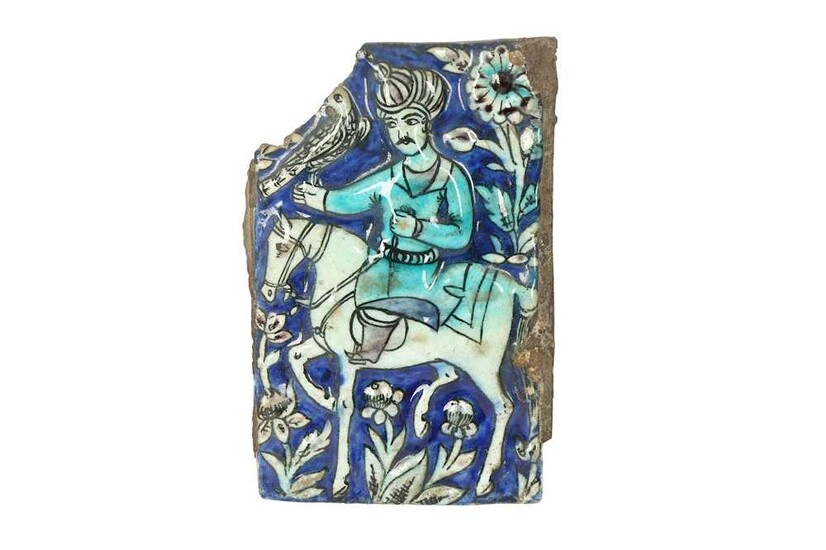A FRAGMENTARY MOULDED QAJAR POTTERY TILE Late Qajar Iran, late 19th/20th century
A FRAGMENTARY MOULDED QAJAR POTTERY TILE, Late Qajar Iran, late 19th/20th century, of fragmentary rectangular shape, painted in cobalt blue, black, manganese purple and turquoise on a white ground, depicting a falconer with his hawk on a white steed, the background with lush floral stems, the back with a picture hook, wire and nail, and two old ownership stickers, 18.7cm x 12.5cm x 4.3cm.
The two stickers at the back of the tile suggest the previous owner researched and enquired about the tile's fragmentary state. One is a printed image depicting a similar tile in the Victoria and Albert Museum's collection (acc. no. 283-1874) with the annotation "A. Lane: Later Islamic Pottery (2nd ed 1971)" referring to the publication Later Islamic Pottery: Persia, Syria, Egypt, Turkey by Arthur Lane and Ralph H. Pinder-Wilson. Glued underneath it is a separate typed line that reads "A. About 1860. Ht 7 3/4 in.". The second sticker is a handwritten note, possibly from a restorer, reading "Made at Isfahan (Persia) (?) tiles of famous mosque Tehran and (?) seventeenth century. Cannot be repaired because impossible to produce the blue. (Mr. Cooros or Kooros.)"
Moulded tiles such as this featuring a mounted falconer were produced throughout the 19th and 20th centuries in Iran, inspired by earlier Safavid figural cuerda seca tiles. They were typically made as a frieze or decorative panel surrounding a larger scene.
(Qty: 1)
18.7cm x 12.5cm x 4.3cm
View it on
Sale price
Estimate
Time, Location
Auction House
A FRAGMENTARY MOULDED QAJAR POTTERY TILE, Late Qajar Iran, late 19th/20th century, of fragmentary rectangular shape, painted in cobalt blue, black, manganese purple and turquoise on a white ground, depicting a falconer with his hawk on a white steed, the background with lush floral stems, the back with a picture hook, wire and nail, and two old ownership stickers, 18.7cm x 12.5cm x 4.3cm.
The two stickers at the back of the tile suggest the previous owner researched and enquired about the tile's fragmentary state. One is a printed image depicting a similar tile in the Victoria and Albert Museum's collection (acc. no. 283-1874) with the annotation "A. Lane: Later Islamic Pottery (2nd ed 1971)" referring to the publication Later Islamic Pottery: Persia, Syria, Egypt, Turkey by Arthur Lane and Ralph H. Pinder-Wilson. Glued underneath it is a separate typed line that reads "A. About 1860. Ht 7 3/4 in.". The second sticker is a handwritten note, possibly from a restorer, reading "Made at Isfahan (Persia) (?) tiles of famous mosque Tehran and (?) seventeenth century. Cannot be repaired because impossible to produce the blue. (Mr. Cooros or Kooros.)"
Moulded tiles such as this featuring a mounted falconer were produced throughout the 19th and 20th centuries in Iran, inspired by earlier Safavid figural cuerda seca tiles. They were typically made as a frieze or decorative panel surrounding a larger scene.
(Qty: 1)
18.7cm x 12.5cm x 4.3cm



